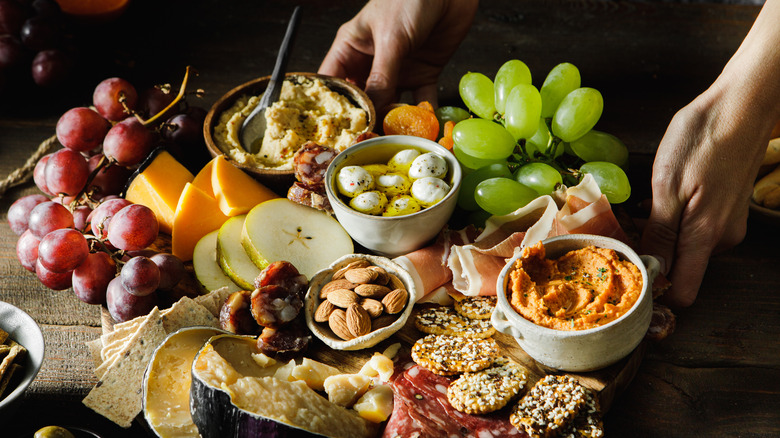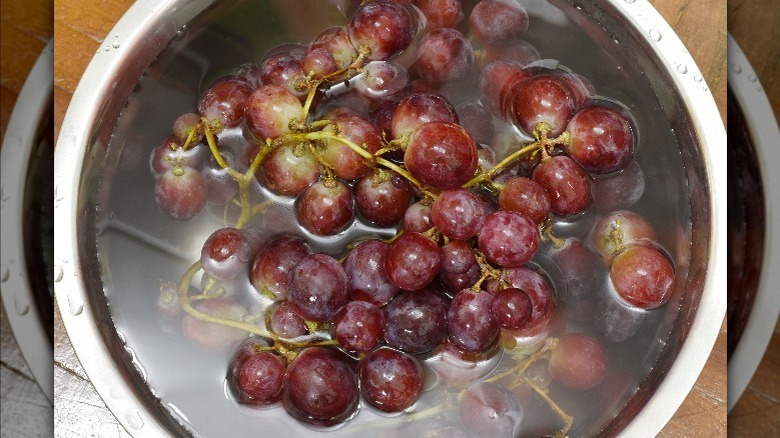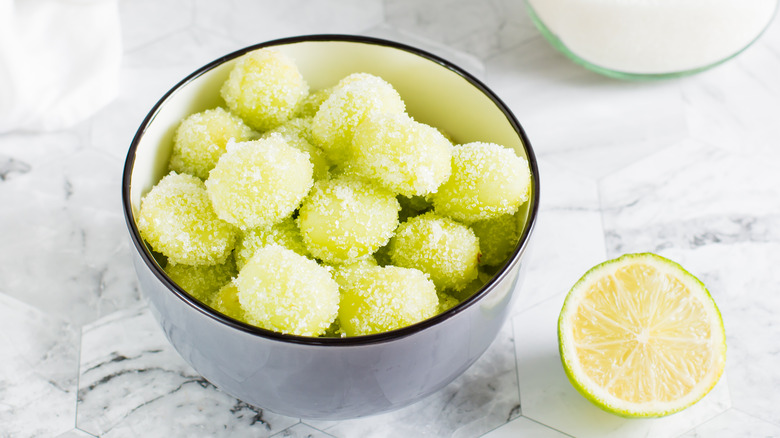Wine Marinated Grapes Are A Sweet, Classy Addition To Any Charcuterie Board
A charcuterie board is characterized by three foundational flavors: something salty, something savory, and something sweet. For the sweet part, you most often see grapes being used; they're affordable and commonplace, plus they taste sugary, so the reasons why are obvious. Even if grapes aren't included, though, wine is usually served alongside the cheeses and meats, so you'll still get your serving of grapes.
It's actually possible to further combine wine and grapes, simply by marinating your grapes in wine. To do this, get your choice of seedless grapes, your favorite type of white wine, and about 1/2 cup of sugar. In a large pitcher, combine the wine and sugar together to form your marinade before adding the grapes.
Refrigerate those grapes in the pitcher for anywhere between 12 to 14 hours. Once the grapes have been sufficiently chilled, drain away the sugary wine mixture and dry off the fruit. You can then either serve the grapes as they are or roll the fruits in more sugar and freeze them for 3 or 4 more hours before serving.
The end result should be a pearl-like piece of fruit with a glossy (and crunchy, if sugar-covered) exterior plus a sweet, tart flavor, similar to the palate of wine. If you don't have any white wine, you can also use different types of wine and even other alcohols to marinate.
Soak grapes in red wine or vodka
Red wine, should you have it, will work just the same as white. Although the process for making red wine-marinated grapes is pretty much the exact same, one minor difference is that you'll want to use red grapes instead of the green table variety. This is mainly an aesthetic choice, as the red ones will more or less keep their color even after soaking in the wine. Green grapes may change to a greenish-red color and, depending on your taste, might not look too appealing on your charcuterie board (though they'll still have the same flavor).
But what about if you want something a little stronger than white or red wine? It's entirely possible to serve vodka-marinated grapes. Much like those other recipes, you'll require your choice of grapes and some sugar, but instead of wine, you'll need vodka.
@brunchwithbabs YUM! 🍾 just cover with a lid or wrap, refrigerate overnight , drain, roll in sugar and enjoy! 🥰. 21 years old to enjoy. #howto
TikTok user brunchwithbabs, for example, recommends combining 1 pound of large green grapes with 2 ounces of vodka — and 2 cups of prosecco white wine. Then, you should refrigerate the covered grapes overnight and later drain off the liquor before rolling the fruit in sugar. If you don't have prosecco or white wine at all, the vodka will work just fine on its own.
You can soak other fruits in alcohol too
While grapes are a popular part of a charcuterie board, that doesn't mean other fruits aren't served alongside all those smoked meats, cheeses, and nuts. These include berries (raspberries, blackberries, blueberries, and strawberries), citrus fruits like lemons or oranges, and peaches, plums, or pineapples. Many of those fruits can also benefit from a quick soak in alcohol to add extra flavor to them.
There are myriad ways to experiment with this, so you're not just limited to wine. You can, for example, soak pineapple chunks in your favorite type of rum, your choice of berries in champagne, or slices of peach in bourbon. In fact, many different kinds of ingredients can actually become vodka infusions, ranging from dill pickles and horseradish to cucumbers and mint.
Imagine having a piece of smoked Gouda with white wine-infused grapes or a piece of prosciutto with a slice of peach that's infused with rich bourbon. Your charcuterie board is meant to be a palette of different flavors and textures. So, customizing it with a variety of new tastes and combinations is the difference between a good charcuterie board and a bad one.


